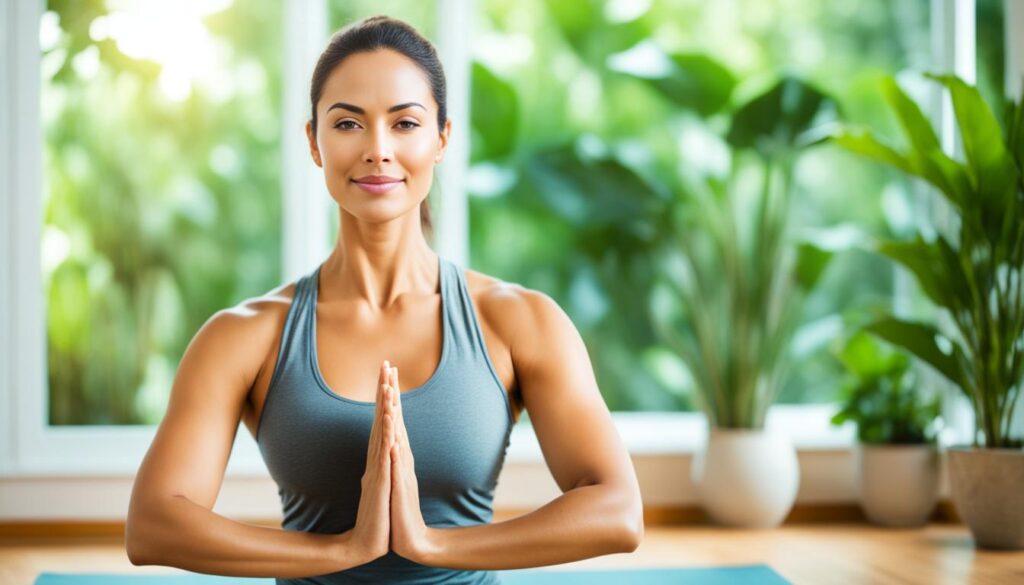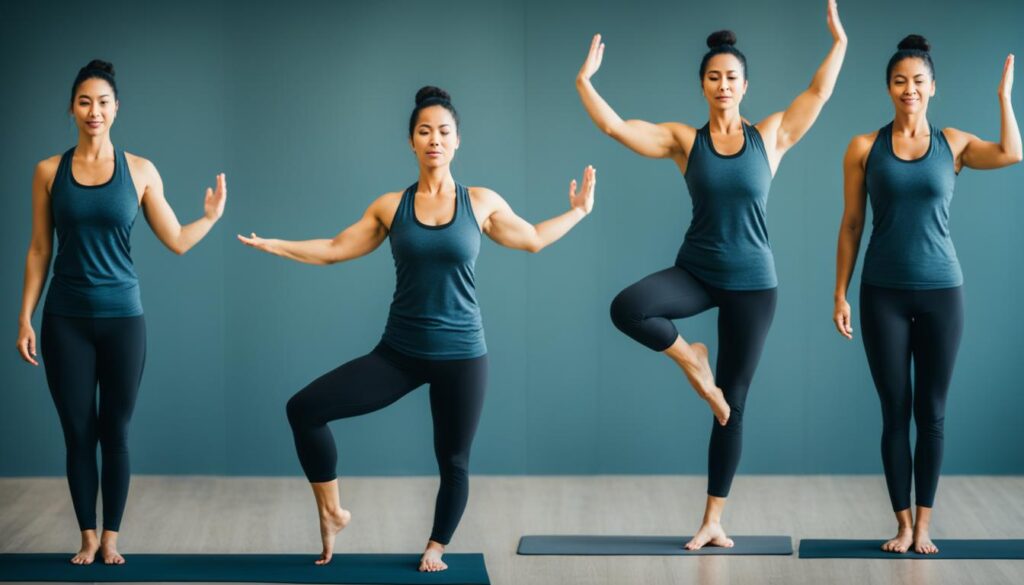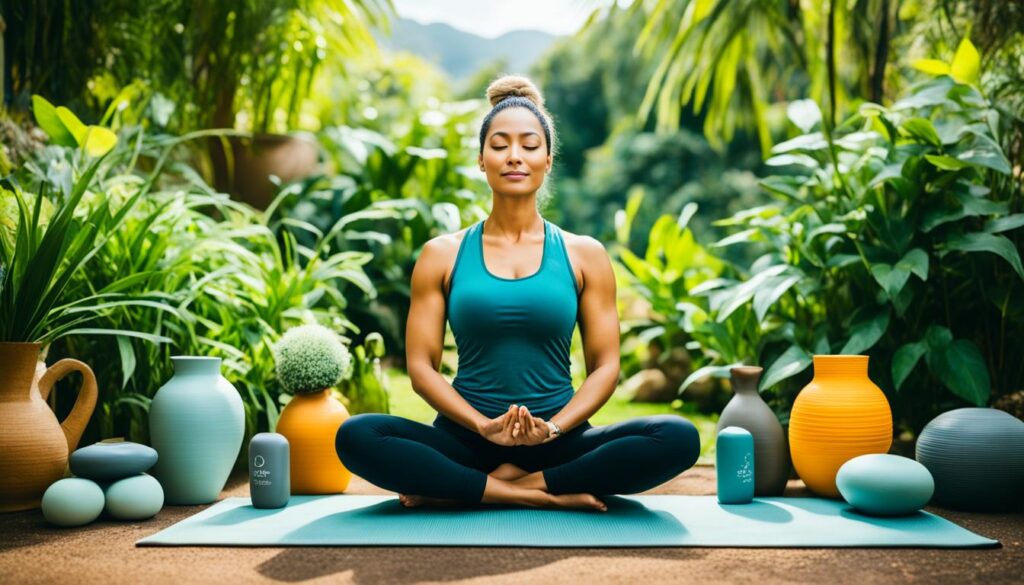Yoga has been proven to deliver numerous benefits for both physical and mental health, from increased flexibility and strength to reduced stress and anxiety. However, one question that many yoga practitioners struggle with is how often they should do yoga to reap the maximum benefits it has to offer.
The frequency of your yoga practice depends on a variety of factors, including your experience level and personal goals. In this section, we will explore the importance of yoga frequency and provide guidelines on how often you should practice to maximize the benefits of yoga for your overall well-being.
Key Takeaways:
- Determining the frequency of your yoga practice depends on your individual needs, goals, and experience level
- A regular yoga practice can provide numerous physical and mental health benefits
- Beginners should start with a gentle introduction to yoga and slowly increase the frequency over time
- Intermediate and advanced practitioners can benefit from increasing the frequency of their practice to deepen their understanding and enhance the benefits
- It’s important to always listen to your body and adjust your practice accordingly, incorporating variations and rest days as needed
Understanding the Benefits of Yoga
Yoga offers a plethora of benefits for both the mind and body, making it a holistic approach to wellness. In addition to the obvious benefits of improved flexibility and strength, yoga can also reduce stress and anxiety, improve sleep quality, boost immunity, and lower blood pressure. Furthermore, it has been found to enhance focus and overall mental well-being, allowing you to tap into your inner peace and harmony.

One of the key advantages of yoga is that it can be customized to fit your individual needs and goals. Whether you aim to elevate your physical fitness or relieve stress, there is a yoga practice that can help you achieve your objectives. Moreover, the benefits of yoga are not limited to any specific age group or fitness level, making it accessible to all who seek to incorporate it into their lives.
“Yoga is not just repetition of few postures – it is more about the exploration and discovery of the subtle energies of life.”
Amit Ray
Maximizing the Benefits of Yoga
Utilizing the wide range of benefits of yoga is the key to achieving maximum advantage. It’s vital to approach yoga with an open mind and continue progressing towards more advanced poses and techniques. The benefits of yoga are not limited to physical fitness, but extend to overall mental health and well-being, so it’s important to prioritize making yoga a part of your regular routine.
Finding Your Yoga Routine
Establishing a regular yoga routine is essential for maximizing the benefits of your practice. Beginners and advanced practitioners alike need to find the right balance that suits their level of experience. For beginners, it’s best to start with a gentle introduction and gradually increase the frequency over time. On the other hand, those who are more advanced may want to increase the frequency of their practice to deepen their understanding and experience the most benefits.
Remember, finding the right routine is about listening to your body. Yoga is not a one-size-fits-all practice, and your routine should reflect your unique needs and goals. Don’t be afraid to experiment with different styles and practices to find what feels best for you.

Consider factors such as your overall fitness level, flexibility, and specific health concerns when establishing your yoga routine. For example, those with lower back pain may want to focus on gentle poses and stretches that promote spinal health.
Finally, be sure to incorporate rest days into your routine to give your body time to recover and rejuvenate. A well-rounded yoga practice involves finding the right balance between active practice and rest to optimize your overall health and well-being.
Yoga Frequency for Beginners
If you’re just starting your yoga practice, consistency is key. It’s recommended to begin with one to two sessions per week, gradually building up to three to four sessions as your body adjusts. Along with frequency, it’s essential to pay attention to the duration of each session. As a beginner, aim for sessions that last 30-45 minutes, gradually increasing up to 60-90 minutes as you become more comfortable.
To build a solid foundation, it’s crucial to focus on proper alignment and technique rather than trying to push yourself too hard. This will help prevent injury and ensure that you’re getting the most out of each session. As you progress in your practice, you can consider incorporating more advanced postures and increasing the intensity of your sessions.
Remember that everyone’s body is different, and it’s important to listen to yours when determining your yoga frequency. If you feel sore or fatigued, it’s okay to take a break and allow your body time to rest and recover. Additionally, don’t hesitate to consult with a qualified yoga instructor or healthcare professional if you have any concerns about your practice.

Incorporating yoga into your routine can be a transformative experience, even at a beginner level. By starting with a gentle introduction and gradually increasing frequency and duration, you can build a solid foundation for your practice and begin reaping the numerous benefits that yoga has to offer.
Ideal Yoga Frequency for Intermediate Practitioners
As you progress on your yoga journey, you’ll want to continue deepening your understanding and experiencing the benefits. Intermediate practitioners may increase the frequency of their yoga practice to up to 5-6 days a week, but it’s important to listen to the body’s needs and avoid overdoing it.
Remember, yoga frequency is not the only factor in maximizing the benefits of your practice. Consistency and duration of practice, as well as incorporating a variety of poses, also play a significant role.

During the intermediate phase, your yoga practice may evolve to include deeper stretches, more complex poses, and longer durations of practice. However, always prioritize safe alignment and proper breath control to avoid injury.
“The beauty of yoga is that it meets you where you are, and allows you to progress at your own pace.”
Advanced Yoga Practice and Frequency
If you are an advanced yoga practitioner, congratulations on mastering the basics and progressing in your practice. To continue experiencing growth and transformation, it’s crucial to maintain a consistent yoga practice frequency.
For optimum results, you should aim to practice yoga at least 5-6 days a week. However, it’s important to prioritize quality over quantity, ensuring that each session is challenging and engaging. Make sure to continually challenge yourself with advanced postures, but also to include restorative postures after more strenuous sessions to avoid burnout.
As an advanced practitioner, your body has developed the strength and flexibility needed to handle a more intense and frequent yoga practice. Therefore, it’s essential to tailor your practice to your needs and goals. You may want to focus on more challenging poses or target specific areas of your body that need extra attention.
“Yoga is not about self-improvement. It’s about self-acceptance.” —Gurmukh Kaur Khalsa
Remember, yoga is a journey, not a destination. The mindful practice of yoga can offer a range of benefits, including increased flexibility, improved mental clarity, and overall well-being. By practicing yoga at an advanced frequency and level, you are unlocking your full potential and reaping maximum rewards.

Listening to Your Body’s Needs
When setting up a yoga routine, finding the right balance between consistency and flexibility is key to improve your well-being. Even if there are guidelines on how often you should practice yoga, your body’s needs should always be the first priority.

For some people, practicing yoga every day is the best option, while others may benefit from a less frequent routine. Regular practice can do wonders for your health, but it’s essential to pay attention to what your body is telling you. If you feel tired or too sore after a session, decrease the frequency until you build strength and flexibility, but don’t give up.
On the other hand, if you feel great and energized after your yoga practice, you can gradually increase your yoga practice frequency to suit your needs. The right yoga routine enhances your fitness goals, helps you connect with yourself, and ultimately leads to a healthier and happier lifestyle.
Listening to your body is also about distinguishing pain from discomfort. Pushing yourself beyond your limits can cause injuries and undermine the goal of a consistent yoga practice.
“Be mindful, listen to your body, and make adjustments accordingly.
The more attentive you are about recognizing your body’s needs, the more benefits you will reap from your yoga practice.”
Yoga for Better Health and Wellness
| Benefits | How Yoga Can Help |
|---|---|
| Stress Reduction | Yoga practice improves stress management and reduces the production of cortisol, the hormone that triggers stress. Regular practice creates a calming effect and enhances overall relaxation. |
| Physical Fitness | Yoga postures help build strength and flexibility while also improving balance and coordination. Practicing yoga can improve your overall physical fitness level and prepare you for more advanced postures. |
| Better Sleep Quality | Studies have shown that regular yoga practice improves sleep quality and may alleviate the symptoms of insomnia. A consistent routine can help you fall asleep faster and stay asleep longer. |
| Mental Clarity and Function | Through the connection of mind and body, yoga can improve your focus, concentration, and overall mental clarity. |
A regular yoga practice offers many benefits for both physical and mental well-being. Incorporating yoga into your daily routine will help you find a balance that works for you and cultivate a sense of vitality and wellness.
Incorporating Variations and Rest Days
Practicing yoga regularly can help improve your overall health and well-being. However, it’s important to remember that a well-rounded yoga practice involves more than just frequency. Incorporating variations and rest days are also crucial to optimizing your practice and achieving your goals.
When it comes to yoga practice frequency, it’s important to find a routine that works best for you. This routine should include a combination of active practice days and rest days to allow your body to recover. Yoga for better health is all about finding a balance between effort and ease, allowing your body to adapt and grow.
Vary Your Practice
A great way to keep your yoga practice engaging is by incorporating variations into your routine. This can mean practicing different poses or trying out new styles of yoga. These variations can help you work on different areas of your body and prevent boredom in your practice. Overall, this can help enhance your yoga routine and improve your range of motion and flexibility.

Take Rest Days
Rest days are just as important as active practice days. Giving your body time to recover can help prevent injuries and fatigue. It’s essential to listen to your body and take rest days when needed. This can mean taking a break from your regular yoga practice or engaging in gentle restorative poses. Including rest days in your routine can also help prevent burnout and keep your yoga practice sustainable.
Conclusion
When it comes to determining the ideal yoga frequency for maximum benefits, there is no one-size-fits-all answer. It depends on your individual needs, goals, and experience level. However, it’s clear that a regular yoga practice can bring a multitude of benefits to your physical, mental, and emotional health.
By understanding the benefits of yoga, establishing a routine that suits your level of experience, and tuning in to your body’s needs, you can find the right frequency that works for you. Remember to incorporate variations and rest days to achieve a well-rounded practice.
Whether you’re a beginner or an advanced practitioner, the key is to stay consistent and committed to your practice. With time, patience, and dedication, you can unlock the maximum benefits that yoga has to offer.
Start your yoga journey today and discover the transformative power of this ancient practice for your overall health and well-being.
FAQ
How often should you do yoga for maximum benefits?
The frequency of yoga practice for maximum benefits depends on several factors, including your level of experience, goals, and physical condition. However, it is generally recommended to practice yoga at least 3-5 times a week to experience significant improvements in flexibility, strength, and overall well-being.
What are the benefits of yoga?
Yoga offers a wide range of benefits, both physical and mental. It can improve flexibility, strength, and posture, increase mindfulness and overall mental well-being, reduce stress and anxiety, boost immune function, promote better sleep, and contribute to a healthier lifestyle.
How do I find the right yoga routine for myself?
Finding the right yoga routine involves considering your experience level and goals. Beginners should start with basic poses and gradually build up their practice. Intermediate practitioners can incorporate more challenging poses and increase their practice frequency. Advanced practitioners can explore advanced variations and focus on specific areas of interest.
How often should beginners practice yoga?
Beginners should aim to practice yoga at least 2-3 times a week to establish a consistent routine and build a solid foundation. This frequency allows for proper progression, enabling the body to adapt and become accustomed to the practice gradually.
What is the ideal yoga frequency for intermediate practitioners?
Intermediate practitioners can benefit from practicing yoga 4-6 times a week to deepen their understanding of different poses, develop strength, and improve flexibility. This frequency allows for regular progression and continuous growth in their practice.
How often should advanced yoga practitioners practice?
Advanced yoga practitioners who have a strong foundation can engage in their practice 5-7 times a week. This frequency allows them to explore more advanced poses, refine their technique, and experience further transformation and growth.
How important is it to listen to your body’s needs in determining yoga practice frequency?
Listening to your body is crucial when determining how often you should practice yoga. Pay attention to how your body feels after each session and ensure you give yourself enough rest and recovery time. It’s important to honor your body’s limits and adjust your practice frequency accordingly.
Should I incorporate variations and rest days into my yoga routine?
Yes, it’s important to incorporate variations and rest days in your yoga routine. This helps to prevent overexertion, reduce the risk of injuries, and allow your body to recover and rejuvenate. Balancing active practice with rest is essential for maintaining overall health and well-being.
What is the key conclusion on yoga frequency for maximum benefits?
In conclusion, the ideal yoga frequency for maximum benefits varies based on individual needs, goals, and experience level. However, practicing yoga at least 3-5 times a week is generally recommended. By understanding the benefits, establishing a routine, and listening to your body, you can find the perfect balance to reap the maximum benefits yoga has to offer.


Leave a Comment